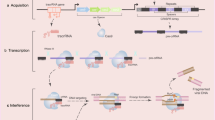Summary
Coculture of two different cell lines in monolayer or spheroids was used to investigate the spontaneous transfer of dominant genes determining drug resistance. MGH-U1 human bladder cancer cells (ouabain-sensitive, mitomycin C-resistant) were cocultured with UV-20 cells (a subline of Chinese hamster ovary cells which is ouabain-resistant and mitomycin C-sensitive). We investigated the possible transfer of mitomycin-C resistance from human to rodent cells by selection in both ouabain and mitomycin C. Regardless of coculture conditions, the frequency of surviving cells was at a similar level to that expected from studies of cell survival when cells were cultured alone. We found no evidence of spontaneous transfer of drug resistance between the two cell lines.
Similar content being viewed by others
References
Cadman, E.; Wong, D.; Liu, E. Drug resistance genes can be spontaneously transferred among malignant cells. In: Hall, T., ed. Cancer drug resistance. New York: Alan R. Liss, Inc.; 1986:11–20.
Chen, T. R.In situ detection of mycoplasma contamination of cell cultures by fluorescent Hoechst 33258 stain. Exp. Cell. Res. 104:255–262; 1977.
Clark, M. A.; Crenshaw, A. H., Jr.; Shay, J. W. Fusion of mammalian somatic cells with Polyethylene Glycol 400 MW. Tissue Cult. Manual 4:801–804; 1978.
Cline, M. J.; Stang, H.; Mercola, K., et al. Gene transfer in intact animals. Nature 284:422–425; 1980.
Debenham, P. G.; Kartner, N.; Siminovitch, L., et al. DNA-mediated transfer of multiple drug resistance and plasma membrane glycoprotein expression. Mol. Cell. Biol. 2:881–889; 1982.
Goldenberg, D. M.; Pavia, R. M.In vitro horizontal oncogenesis by a human tumor in nude mice. Proc. Natl. Acad. Sci. USA 79:2389–2392; 1982.
Gupta, V.; Rajaraman, S.; Gasdon, P., et al. Primary selectivity of contact-mediated intercellular communication in a metastatic mouse mammary tumor line. Cancer Res. 47:5194–5201; 1987.
Ling, V. Genetic basis of drug resistance in mammalian cells. In: Bruchovsky, N.; Goldie, J. H., eds. Drug and hormone resistance in neoplasia, vol. 1. Boca Raton, FL: CRC Press; 1982.
Mariana, B. D.; Schimke, R. T. Gene amplification in a single cell cycle in Chinese hamster ovary cells. J. Biol. Chem. 259:1901–1910; 1984.
Miller, B. E.; Miller, F. R.; Heppner, G. H. Interactions between tumor subpopulations affecting their sensitivity to the antineoplastic agents cyclophosphamide and methotrexate. Cancer Res. 41:4378–4381; 1981.
Miller, B. E.; Roi, L. D.; Howard, L. M., et al. Quantitative selectivity of contact-mediated intercellular communication in a metastatic mouse mammary tumour line. Cancer Res. 43:4102–4107; 1983.
Milner, K. M.; Kawaguchi, T.; Uba, G. W., et al. Clonal drift of cell surface, melanogenic, and experimental metastatic properties ofin vivo selected, brain meninges-colonizing murine B12 melanoma. Cancer Res. 42:4631–4638; 1982.
Poste, G.; Doll, J.; Fidler, I. J. Interactions among clonal subpopulations affect stability of the metastatic phenotype in polyclonal populations of B16 melanoma cells. Proc. Natl. Acad. Sci. USA 78:6226–6230; 1981.
Reddy, E. P.; Reynolds, R. K.; Santos, E., et al. A point mutation is responsible for the acquisition of transforming properties of the T24 human bladder carcinoma oncogene. Nature 300:149–152; 1982.
Rubin, J. S.; Joyner, A. L.; Bernstein, A., et al. Molecular identification of a human DNA repair gene following DNA-mediated gene transfer. Nature 306:206–208; 1983.
Schimke, R. T. Gene amplification, drug resistance, and cancer. Cancer Res. 44:1735–1742; 1984.
Steel, G. G. Cell loss as a factor in the growth rate of human tumors. Eur. J. Cancer 3:381–387; 1967.
Sutherland, R. M. Cell and environmental interactions in tumor microregions: the multicell spheroid model. Science 240:177–184; 1988.
Thompson, L. H.; Rubin, J. S.; Cleaver, J. E., et al. A screening method for isolating DNA repair-deficient mutants of CHO cells. Somatic Cell Genet. 6:391–405; 1980.
Tofilon, P. J.; Buckley, N.; Deen, D. F. Effect of cell-cell interactions on drug sensitivity and growth of drug-sensitive and resistant tumor cells in spheroids. Science 226:862–864; 1984.
Author information
Authors and Affiliations
Rights and permissions
About this article
Cite this article
Luk, C.K., Tannock, I.F. Evaluation of the probability of spontaneous transfer of drug resistance between cells in culture. In Vitro Cell Dev Biol - Animal 27, 245–248 (1991). https://doi.org/10.1007/BF02630924
Received:
Accepted:
Issue Date:
DOI: https://doi.org/10.1007/BF02630924




